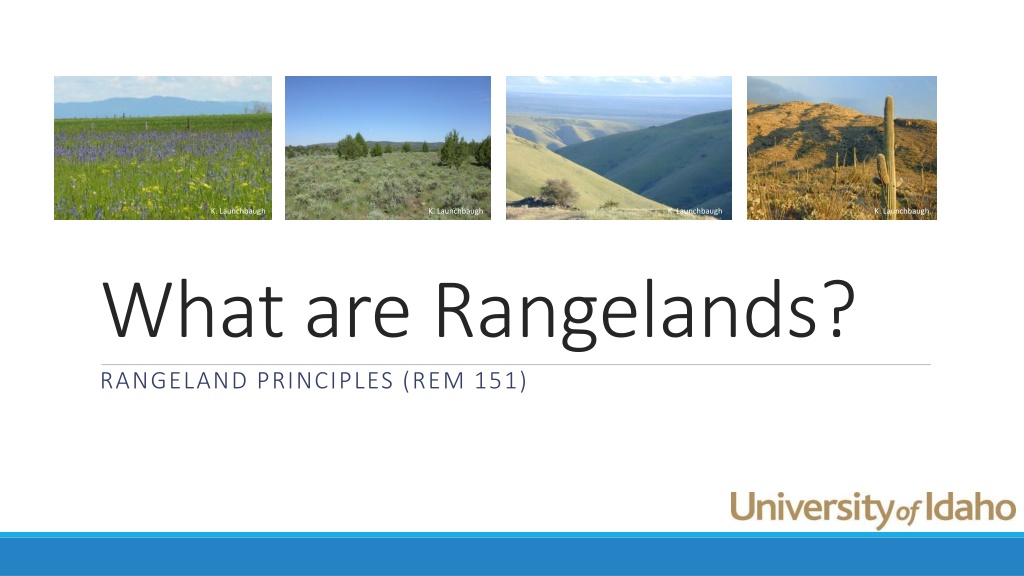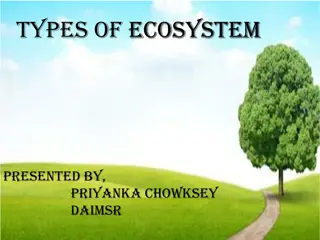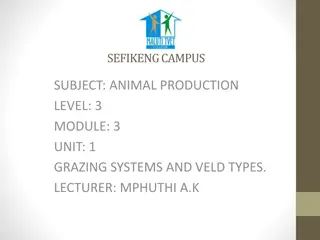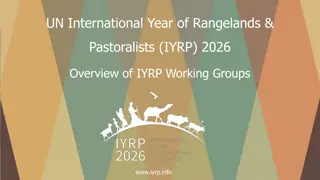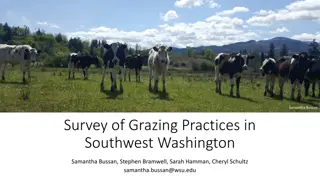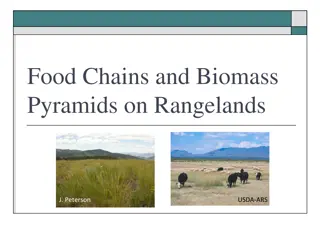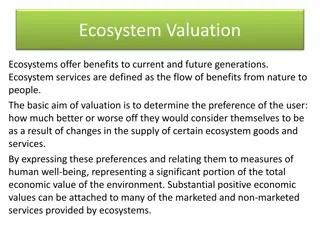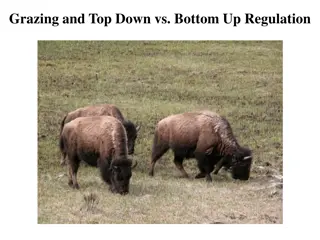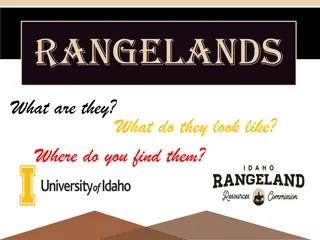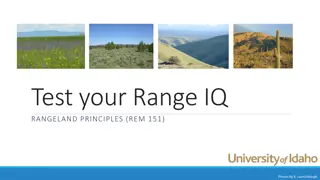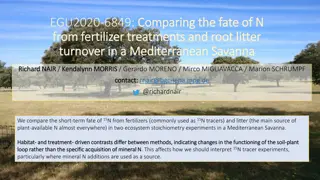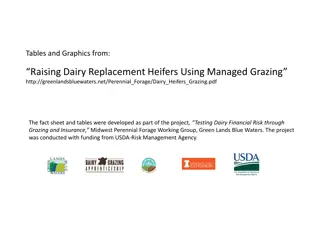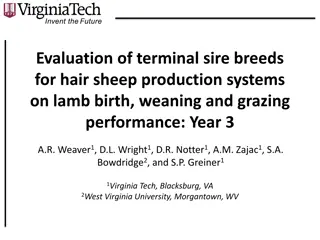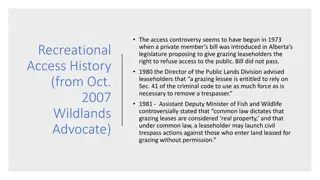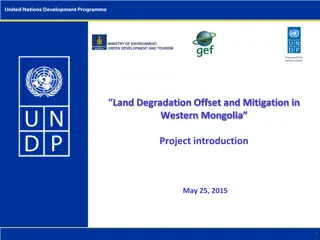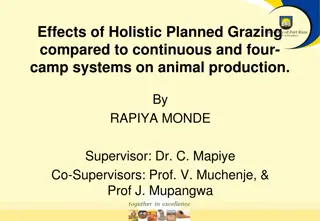Understanding Rangelands: An Overview of Ecosystem Diversity and Grazing Practices
Rangelands encompass various landscapes like grasslands, savannas, deserts, and woodlands, supporting diverse plant life without irrigation. They are not suitable for farming or timber production due to factors like limited precipitation and rocky terrain. Grazing, a vital ecological process, occurs in all rangelands by wildlife, insects, and sometimes livestock.
Download Presentation

Please find below an Image/Link to download the presentation.
The content on the website is provided AS IS for your information and personal use only. It may not be sold, licensed, or shared on other websites without obtaining consent from the author. Download presentation by click this link. If you encounter any issues during the download, it is possible that the publisher has removed the file from their server.
E N D
Presentation Transcript
K. Launchbaugh K. Launchbaugh K. Launchbaugh K. Launchbaugh What are Rangelands? RANGELAND PRINCIPLES (REM 151)
What are Rangelands? Which of these are Rangeland? Deserts? Tundra? Wetlands? Savannas? Shrublands? Forests? Grasslands? Pastures? K. Launchbaugh K. Launchbaugh J. Peterson J. Peterson K. Launchbaugh
What are Rangelands? Which of these are rangeland? Deserts? All deserts except barren deserts Tundra? All tundra Wetlands? Vegetation around streams, ponds, springs, lakes, etc. K. Launchbaugh Savannas? K. Launchbaugh All savannas Shrublands? All shrublands Forests? Only open forests where grass and forbs can grow J. Peterson Grasslands? All grasslands Forage pasture? Not highly managed pastures
Pasture vs Range Pastureland differs from rangeland: Periodic cultivation is used to maintain. Generally introduced (or non-native) forage species. Usually irrigation or fertilization. Managed by agronomic rather than ecological principles. Lynn Betts USDA-NRCS BLM
What are Rangelands? Wild Open Spaces Grasslands, shrublands, woodlands, deserts, savannas, tundra, steppe, and prairies. Naturally growing plants not irrigated or fertilized. Very diverse dry or moist, hot or cold, nearly barren to densely vegetated. Soils most and least fertile soils on earth. No large trees . vast open spaces . See for miles and miles. J. Peterson
What are Rangelands? Linee - Flick All areas that are not: Barren Desert Farmland Closed-Canopy Forest Covered by solid rock, concrete or glaciers C. Thompson J. Fowlers - Flickr Jeff Vanuga USDA-NRCS M. Button
What are Rangelands? Rangelands are shrublands, grasslands, deserts, woodlands, and open forest. K. Launchbaugh J. Corbett Several factors can preclude farming or timber production on these: Limited precipitation Sandy, saline, or wet soils Steep topography Rocks K. Launchbaugh
Rangelands and Grazing Are all rangelands grazed? Grazing is an important ecological process in all rangeland. But not all rangelands are grazed by livestock. All rangeland are grazed by some sort of animal wildlife and insects. Rangelands are a kind of land not a specific land use. K. Launchbaugh
Why are rangelands important? They cover a lot of ground! 47% of the EARTH is rangeland (some estimates as high as 70%) 36% of the US is rangeland 53% of Western States is rangeland 54% of Idaho is rangeland 80 % of Nevada
Why are rangelands important? More rangeland than anything else 47% = Rangeland 25% = Dense Forest 10% = Cropland 3% = Urban 15% = Ice, rock, and barren desert Michael Haddock
Rangelands are Diverse and Extensive! Tundra of the Arctic Across the globe Across the globe Sagebrush Steppe Mongolian Plains Billy Lindblom-Flickr Matt Lavin Mike Hale African Savannah J. Peterson Sonoran Desert Leo Li - Flickr K. Launchbaugh Matt Lavin Cerrados of Brazil Outback of Australia Matt Lavin K. Launchbaugh
Rangelands are Diverse and Extensive! Arctic Tundra Mountain Grasslands Across the globe Across the globe Across the globe Across the globe USFWS/gpv Seth McFarland Oak Woodlands Plains Grasslands Lynn Betts USDA-NRCS B.Spengler Mixed Prairie Sonoran Desert K. Launchbaugh USFWS
Rangelands are Important Wildlife Habitat Forage Livestock Production NPS.gov Water NRCS.USDA.gov Renewable Energy USDA.gov Recreation BLM.gov Native Plants BLM.gov Open Space BLM.gov Jen Peterson Michale Haddock
Rangelands are Challenged Many forces that threaten rangeland integrity! J. Peterson
Rangelands are Challenged Many forces that threaten rangeland integrity! Unsustainable grazing practices Damaging fire regimes Invasive plant species Global climate change Human development J. Peterson
